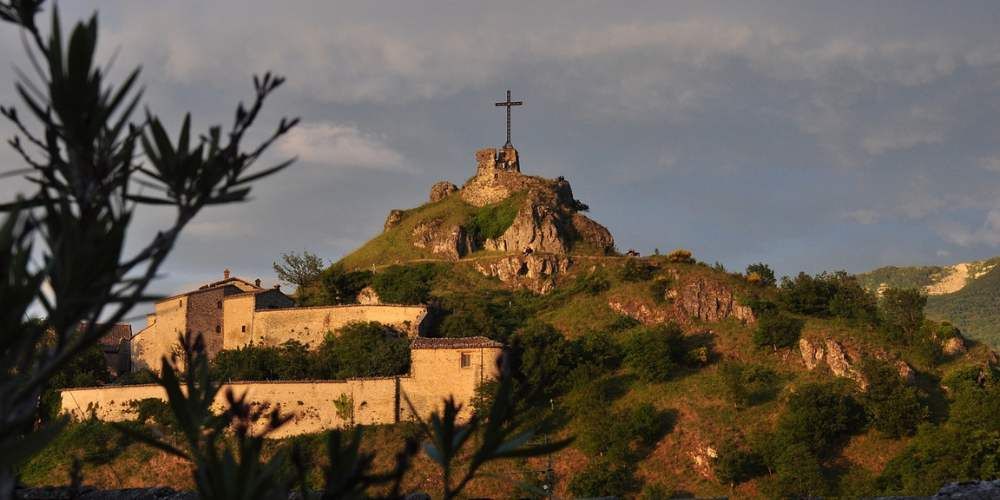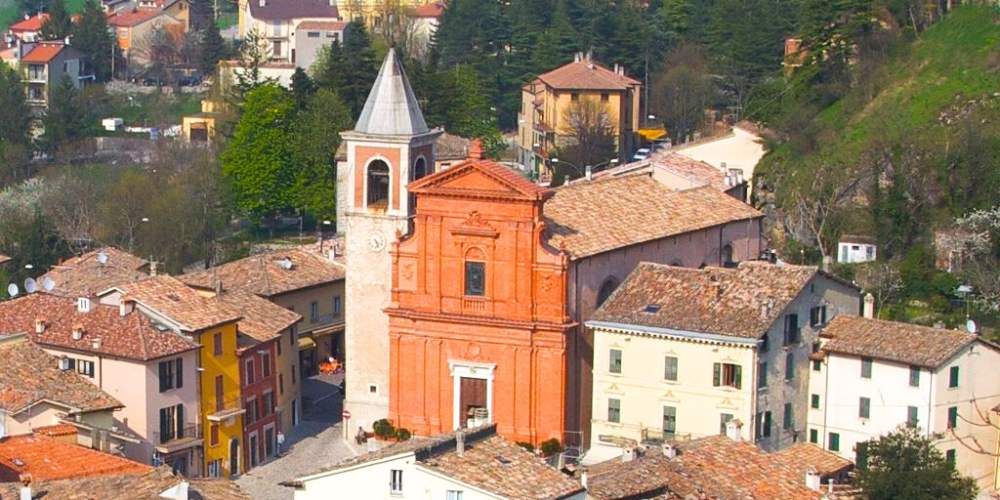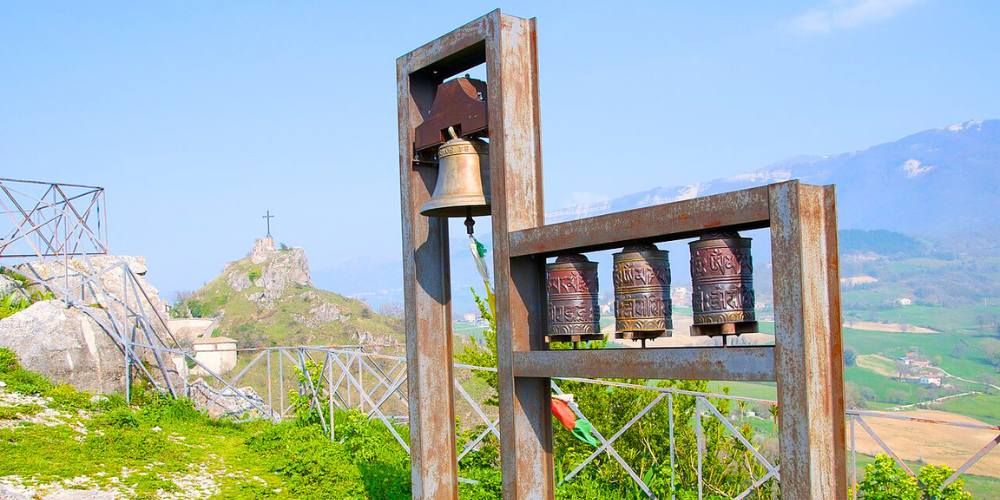In the southernmost part of the province of Rimini, just a few kilometers from the border of the Marche region, lies Pennabilli, a surprising Italian village with a wealth of things to see.
The landscape that embraces Pennabilli is that of the Alta Valmarecchia, where verdant hills alternate with more rugged places.
These are the places where the poet and artist Tonino Guerra, friend of Federico Fellini, lived, but they are also the places visited by the Dalai Lama to celebrate the centuries-old connection of the small village of Pennabilli with Tibet. Not to mention that, according to some, the mysterious panorama evoked in the painting of the Mona Lisa is precisely that of Pennabilli...
Art, history, legends, but also amazing nature and mouthwatering regional gastronomy make Pennabilli an unmissable stop on a trip to this charming corner of Romagna.
Discover with us what to see in Pennabilli, Italy!

What to see in the enchanting Pennabilli, Italy

The town of Pennabilli, which does not even have 3,000 inhabitants, or rather, as they call themselves here, 3,000 Pennesi, is located at an altitude of about 600 meters above sea level.
The fact that the town is small, however, should not be misleading at all, because the memories of this place are lost since Etruscan and Roman times.
The two hills, now called Roccione and Rupe, were then used as a refuge at the time of the so-called barbarian invasions by the people of the Marecchia Valley.
Thus were born the communities of Penna and Billi, where Penna comes from Pinna and means "top," "pinnacle," while Billi comes from Bilia and means "top among the trees". While the former community developed autonomously, the latter became one of the strongholds of the powerful Malatesta family.
In 1350, the two villages were united and, to symbolize this union, "the stone of peace" was laid in the Market Square located between the two centers.
With the Unification of Italy, the town became part of the Marche Region: only in 2006, with a referendum, did the town request to be part of the Emilia Romagna Region and, therefore, of the province of Rimini.
Of stories, this town certainly has many to tell, and we will discover them, one by one, revealing what to see in beautiful Pennabilli in Italy.
Here are the things not to miss in this village in the Marecchia Valley.
The city walls and the gates to the town.
The ancient city walls, which still embrace the historic center of Pennabilli today, continue to give the town its medieval appearance.
What we would like to tell you about Pennabilli's walls, however, is an ancient legend.
In fact, in the 16th century, Pope Leo X gave Lorenzo de Medici the title of Duke of Urbino. The people of Pennabilli, however, rebelled against this new domination so that the Medici troops immediately besieged the town with about 20,000 soldiers. How could Pennabilli save itself from such an attack? It is said that on February 23, 1517, it was an apparition of the Virgin Mary on the town walls that put the besiegers to flight.
To enter the historic center of Pennabilli you will pass through its gates: some particularly interesting ones are Porta Cinzia, Porta dei Malatesta and Porta dei Billi.
What to see in Pennabilli, Italy: the Cathedral of San Leone

San Leone Cathedral and is a splendid Latin-cross building with a neoclassical facade that towers over the city center.
It has been the seat of the diocese of San Marino and Montefeltro since the 16th century.
The Sanctuary of Madonna delle Grazie
The Church of Sant'Agostino is actually better known as the Santuario della Madonna delle Grazie (Sanctuary of Our Lady of Grace) because of the image of the enthroned Virgin and Child.
This image, in fact, is the protagonist of another miracle, that of the Lacrimation of 1489, which is celebrated even today every third Friday in March called, for this reason, Venerdì Bello (Good Friday). The same Madonna was the protagonist of the apparitions that saved Pennabilli from the Medici in the 16th century.
The Monastery of Sant'Antonio da Padova for an enchanting view
Among the things to see in Pennabilli, Italy, is definitely the Monastery of Sant'Antonio da Padova, inhabited by the Augustinian Sisters.
The 16th-century building is located near the ancient fortress of Billi and allows the view to expand over the splendid panorama of the surrounding valley.
The amazing Museums of Pennabilli
One cannot leave this town without visiting its museums.
Dedicated to history, to the surrounding nature, but also to art, they offer an extraordinary insight into the reality of Montefeltro, suspended between past and present.
Here are the museums in Pennabilli that we suggest you visit.
The widespread museum, called The Places of the Soul
As we anticipated, the life of poet and artist Tonino Guerra was closely intertwined with Romagna and, therefore, also with Pennabilli.
The diffuse museum "I Luoghi dell'Anima" (literally, the Places of the Soul) winds its way through the historic center of Pennabilli and part of the Marecchia Valley. The intent is to be an inspiration for a kind of "poetic awakening" in the visitor's mind. There are 7 places that make up this open-air museum.
The most famous is certainly The Garden of Forgotten Fruits, where it is possible to rediscover species of fruit trees that are no longer cultivated. Here you can also find the "Peace Mulberry Tree," planted by the Dalai Lama himself.
Also surprising is the Road of Sundials, in the historic center of Pennabilli. Seven sundials, in fact, embellish the facades of the buildings with the intention of paying homage to the different methods of calculating time over the centuries.
You can visit the installations daily and free of charge.
Mateureka, the Museum of the Calculation
Inside the Municipal Palace is Mateureka, the museum that aims to showcase the history of calculus and mathematics. Exhibits range from Sumerian tablets to Japanese sorobans, not to mention graphometers and arithmographs. There are also virtual reality helmets and laboratories where you can experiment with ancient calculus tools and play with the rules of mathematics.
In short, a museum of extraordinary originality!
The Sasso Simone and Simoncello Park Museum
The Sasso Simone and Simoncello Regional Park, in fact, shared between the provinces of Pesaro Urbino and Rimini, is an amazing territory covering nearly 5 thousand hectares.
Pennabilli's museum dedicated to the park invites visitors to discover the local flora and fauna. Located in the building of the former Pennabilli slaughterhouse, the museum replicates local animals in interesting dioramas, displays an unsuspected collection of minerals and invites visitors to learn more about the nature of the area through hands-on and interactive workshops.
The Lhasa bell

We anticipated Pennabilli's connection to Tibet. It all starts with Father Horace della Penna leaving for Asia with the intention of bringing the Gospel. In truth, he does more than just that. His merits include editing the first Italian-Tibetan dictionary and bringing the first movable type printing to Tibet. Father Orazio, born Orazio Olivieri, had brought with him to Lhasa a bell that had been forged in Rome. In 1994, the bell was found in Jokhang. A cast of the bell was then brought to Pennabilli and unveiled in 2005 by Tenzing Gyatso, the 14th Dalai Lama of Tibet.
This story tells of a profound dialogue between cultures, religions and the profound recognition to the work of Horace della Penna, affectionately called "white-headed lama" in Tibet.
What to do in Pennabilli, Italy
Not only things to see, but also many things to do in Pennabilli.
One of the most interesting things to participate in is the Procession of the Jews of Pennabilli. It is organized on Good Friday and takes place at night. 70 figures, dressed in Roman-era costumes, including pious women, soldiers and hooded men, make their way from the Misericordia Church to the Monastery of Sant'Antonio. Illuminating the long procession is only the light of torches.
Also not to be missed is the Pennabilli Festival, Artisti in Strada. Held in the first days of June, it is a performing arts festival that makes Pennabilli a picturesque art capital. Dozens of concerts, theater and new circus performances color the streets of the town and enrich it with events and music. During the festival, the Mercatino del solito e dell'insolito (Market of the usual and the unusual) is also usually offered, where the highest quality handicrafts, the result of careful selection, are displayed.
July, on the other hand, is the time for the Pennabilli Antiques Market, one of the most important and oldest in Italy.
Rounding out the year is the Django Festival, dedicated to Jazz Manouche music and its most famous exponent, Belgian artist Django Reinhardt.
What to eat in Pennabilli
Not only culture and nature, but also food. And what food!
In fact, the Marecchia Valley area is a symphony of delicious flavors embodied in a variety of typical products that you will only find here. Pennabilli is famous for its blackthorn mushroom, which is celebrated during a Festival held in Miratoio di Pennabilli at the end of May.
Also delicious are the honey from Poggio Torriana, the black truffle and white truffle from Sant'Agata di Feltria and the Balsamo di Cagliostro produced in San Leo: this is a special herbal liqueur dedicated to the alchemist Giuseppe Balsamo.
There is, of course, no shortage of oil, particularly good and to be enjoyed as a condiment on bruschetta, and wine.
Sangiovese and Trebbiano, a red and a white wine, respectively, are among Italy's most famous wines.
How to get there
The nearest airport is Rimini, located about 40 kilometers away. The village can be reached by bus from Rimini, or by car. The nearest highway exit is Rimini Nord.
We hope this itinerary in the heart of Pennabilli has been a mouth-watering inspiration for your next trip to this amazing land!
About the author
Written on 14/04/2023




Elisa Borgato
Discover with us Pennabilli, in Italy, the beautiful town in the province of Rimini. The things to see and the festivals will truly amaze you.